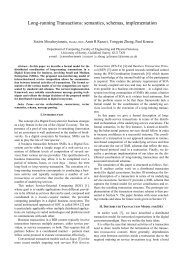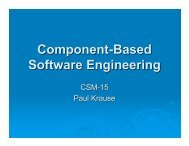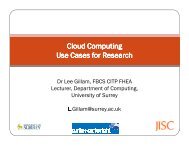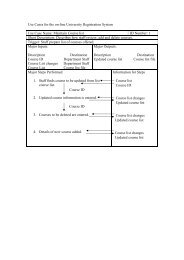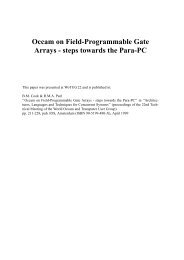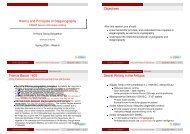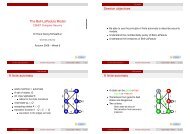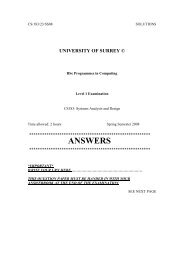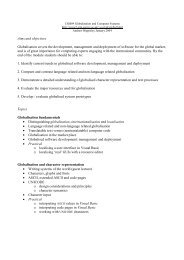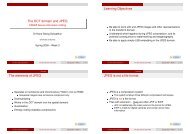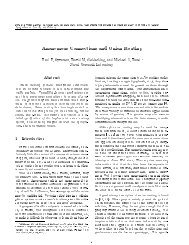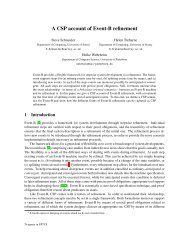Corpus-Based Thesaurus Construction for Image Retrieval in ...
Corpus-Based Thesaurus Construction for Image Retrieval in ...
Corpus-Based Thesaurus Construction for Image Retrieval in ...
You also want an ePaper? Increase the reach of your titles
YUMPU automatically turns print PDFs into web optimized ePapers that Google loves.
the construction of a thesaurus from doma<strong>in</strong>-specific texts <strong>for</strong> query expansionpurposes.The development of digital visual archives br<strong>in</strong>gs with it the problem of <strong>in</strong>dex<strong>in</strong>gthe images <strong>in</strong> the archives. These <strong>in</strong>dices act as the equivalent of keywords used to<strong>in</strong>dex text documents. The currently available digital archives range from medicalimage archives to archives of the images of pa<strong>in</strong>t<strong>in</strong>gs and press-agency photocollections.Dur<strong>in</strong>g the last three decades significant ef<strong>for</strong>t has been spent on systemsthat focus exclusively on vision-specific features such as colour distribution, shapeand texture, often called content based image retrieval systems (CBIR), and this termcan be used to describe many research as well as commercially available systems [1].However, CBIR systems have an implicit limitation <strong>in</strong> that visual properties cannot,<strong>in</strong> themselves, be used to identify arbitrary classes of objects. Indeed there aretheoretical limitations on us<strong>in</strong>g the visual features <strong>for</strong> describ<strong>in</strong>g an image [2] and,recently, some practical limitations of such an approach have been outl<strong>in</strong>ed as well[3]. Earlier image retrieval systems, as well as the images retrieved by the searcheng<strong>in</strong>es, rely almost exclusively on keywords. The problem here is that append<strong>in</strong>gkeywords to an image is not only quite time consum<strong>in</strong>g, the estimates vary fromm<strong>in</strong>utes to hours [4][5], but the choice of keywords may <strong>in</strong> themselves show the biasof the <strong>in</strong>dexer. This has led to the so-called multimodal systems, which essentially usel<strong>in</strong>guistic features extracted from textual captions or descriptions together with thevisual features <strong>for</strong> stor<strong>in</strong>g and retriev<strong>in</strong>g images <strong>in</strong> databases. The term<strong>in</strong>ology used <strong>in</strong>the description of such systems is <strong>in</strong>dicative of the multimodal nature: Picard’s Visual<strong>Thesaurus</strong> [6]; Srihari’s arguments on ‘texts’ that are collateral to an image [7].<strong>Retrieval</strong> is shown to be more effective when textual features are used togetherwith the visual features, <strong>for</strong> example [8] show a mild improvement on precision andrecall statistics when the comb<strong>in</strong>ed features were used to query an image databasecompared to when either text or visual features were used, but there are stilllimitations where the keywords are concerned <strong>in</strong> that the use of synonyms,abbreviations or related words as well as broader or narrower words is not taken <strong>in</strong>toaccount. The issue of <strong>in</strong>ter-<strong>in</strong>dexer variability [4], the variation <strong>in</strong> the verbal outputsof different <strong>in</strong>dexers <strong>for</strong> the same image, has shown a use of related terms. The termquery expansion 2 refers to the addition of search terms to a user's search <strong>for</strong>improv<strong>in</strong>g precision and/or recall. The additional terms may be either taken from athesaurus or from documents that the user has specified as be<strong>in</strong>g relevant. A thesaurusis a “controlled and dynamic vocabulary of semantically and generically relatedterms, which covers a specific doma<strong>in</strong> of knowledge”[9]. The most commonrelationships <strong>in</strong> a thesaurus are related terms (RT), broader terms (BT) and narrowerterms (NT). There do exist some general purpose thesauri, Roget’s[10] thesaurusbe<strong>in</strong>g the classic example, as well as lexical resources such as WordNet 3 but theproblem is that their coverage is too broad render<strong>in</strong>g them <strong>in</strong>adequate <strong>for</strong> use <strong>in</strong>specialized doma<strong>in</strong>s such as <strong>for</strong>ensic science or medic<strong>in</strong>e. Hence when images of aspecialist nature are to be stored there is a problem <strong>in</strong> that the thesauri and relevantdocuments <strong>for</strong> query expansion are not readily available establish<strong>in</strong>g the need tocreate doma<strong>in</strong>-specific thesauri. These could be manually built by expert2 http://wombat.doc.ic.ac.uk/foldoc/ (Site visited 13 Nov 2002)3 http://www.cogsci.pr<strong>in</strong>ceton.edu/~wn/



